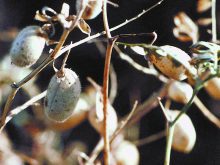Turkish crop looks promising despite a rough start, while there is little market intelligence on Russian chickpeas
Canadian kabuli chickpea prices in 2023-24 will largely depend on what happens in Russia and Turkey, says a processor of the crop.
Colin Young, manager of Midwest Investments, a chickpea cleaner in Moose Jaw, Sask., said those are Canada’s two top competitors and global kabuli chickpea supplies are tight.
“If one of those two countries has a production issue, chickpeas are drastically short for the year and the atmosphere will change overnight,” he said.
Yusuf Memis, foreign trade manager of Bashan Pulses, one of Turkey’s leading pulse exporters, recently told the Global Pulse Confederation that Turkey’s crop is looking good despite a rough start.
Read Also

U.S. softens fees on Chinese shipping
The U.S. starts charging new fees on Chinese ships on Oct. 14. What are the ramifications for their ag exports?
“After early drought warnings in January-February, we’ve had good rains in March, April and May and we aren’t expecting any decrease in yield or quality,” he said. “So far, so good.”
Memis told GPC that Turkey typically harvests about 350,000 tonnes, while domestic consumption is estimated at 100,000 to 120,000 tonnes. The rest is exported.
Young said Turkey produces the same type of kabulis as Canada. It keeps the nine-millimetre calibre and exports the eight mm size.
There is little market intelligence about Russia’s crop. Young said there is no reason to believe there will be a dramatic change in acres.
Russia typically produces and exports 200,000 to 350,000 tonnes of seven mm types. They tend to set the floor for kabuli prices.
Growers in Russia and Turkey often sell about half their crop straight off the combine and are more willing than Canadian growers to accept lower prices.
That could pressure prices for a while. Turkey’s crop hits the market in August, while Russia’s will be ready in September or October.
But world stocks are so tight that he believes prices are more likely to remain steady until the end of 2023, when Russian and Turkish supplies dwindle.
Then prices could climb, although Young doubts they will get to the 70 cents per pound range of four years ago. Supplies were tight last year, but buyers balked when prices hit 56 cents per lb.
Statistics Canada is forecasting 260,000 acres of Canadian chickpeas, an 11 percent increase over last year. He thinks that sounds about right.
The U.S. Department of Agriculture is forecasting 340,500 acres of U.S. chickpeas, a four percent drop from last year. But Young said there is one big difference between this year and last.
“We’ve chewed through the vast majority of the carryover that we had,” he said.
He is having a tough time sourcing old crop chickpeas with a bid of 52 cents per lb., which is at the high end of the historical range.
The North American crop is off to a good start and Young expects average yields and quality unless there is frost damage because of the late start to seeding.
Harvest is just wrapping up in Mexico, a market that establishes the price ceiling for kabulis with its extra-large 11 to 13 mm chickpeas.
Sahid Hernandez, trade manager with Terminel, told GPC that Mexico’s crop was disappointing.
“It’s approximately 20 to 25 percent smaller (than last year),” she said in an article published on the GPC website.
Mexican growers opted to plant corn instead of chickpeas because there was plenty of water at seeding time and corn offers better price certainty for growers.
Hernandez said Mexico cannot fully meet its usual export demand for the chickpeas.
“International demand tends to hover around 120,000 tonnes,” she told the GPC.
“This year we’ll have little more than 70,000 tonnes, and that’s before removing the product that isn’t high enough quality for export.”
Hernandez said Mexican chickpeas were selling for US$1,790 to $1,840 per tonne at the time the article was published in mid-May. Prices were bolstered by rising prices in India.
“What we’re seeing now is that the quality and quantity that was expected from India has turned out not to be as good as they’d hoped for, which has caused their price to rise again, setting up a more bullish Mexican chickpea price,” she said.
Navneet Chhabra, a trader with Global Garbanzo, told GPC in a separate article published at the end of March that Indian farmers increased kabuli acres by 30 percent in 2023.
The expectation was that there was a big crop on the way, so traders sold 25,000 to 30,000 tonnes on forward contracts for shipment in March and April.
“But yields have been disappointing and now traders are looking to cover their short sales. In response, market prices are going up,” he said.
A seven-day stretch of hot weather in mid-December sapped yields, offsetting the 30 percent increase in acres.
Chhabra told GPC he expects 300,000 to 350,000 tonnes of kabulis, instead of the 400,000 to 450,000 tonnes forecast at the start of the year. There is no carryout.
He believes India’s exports will be between 50,000 and 75,000 tonnes, which is a small program.
Young said Canada does not compete directly with chickpeas out of Mexico and India because they are a much larger product.
But it competes with Argentina, another market that is struggling. It has no carryover and not a lot of new acres coming.
“They will be a very minor player in chickpeas this year,” he said.


















